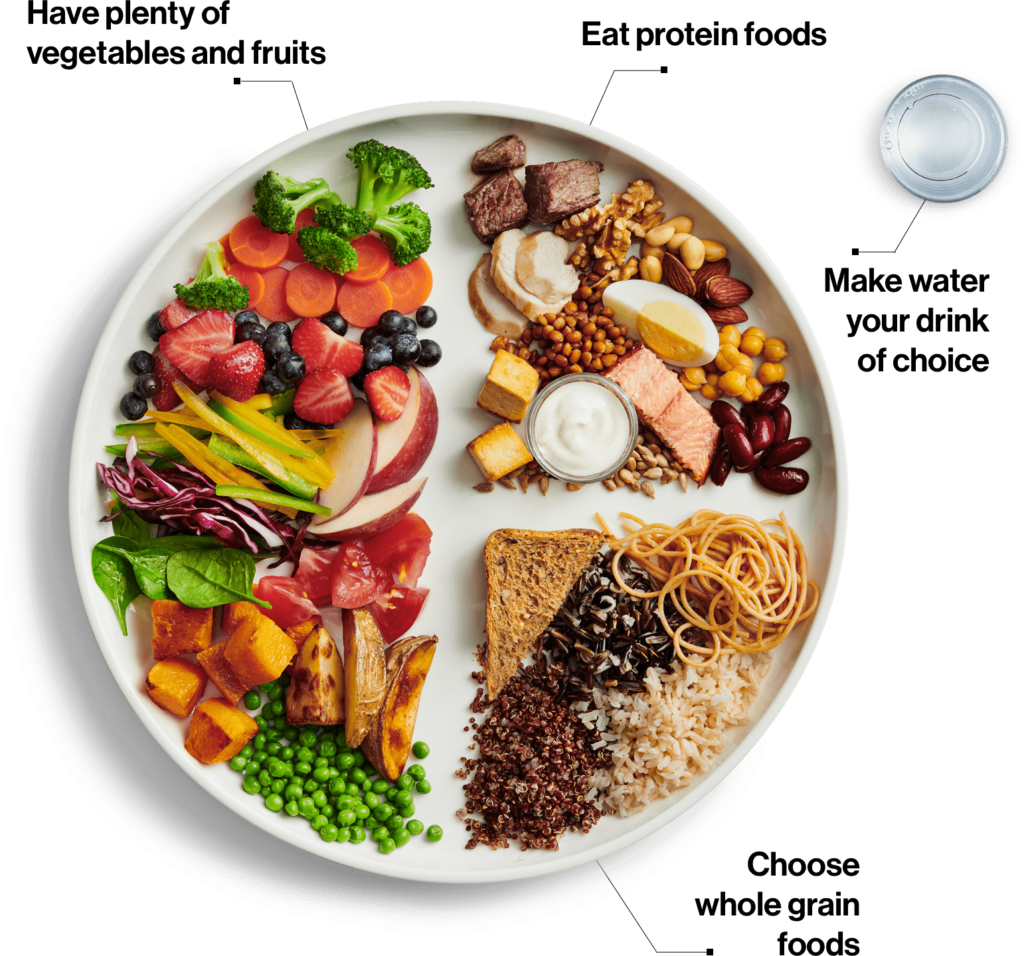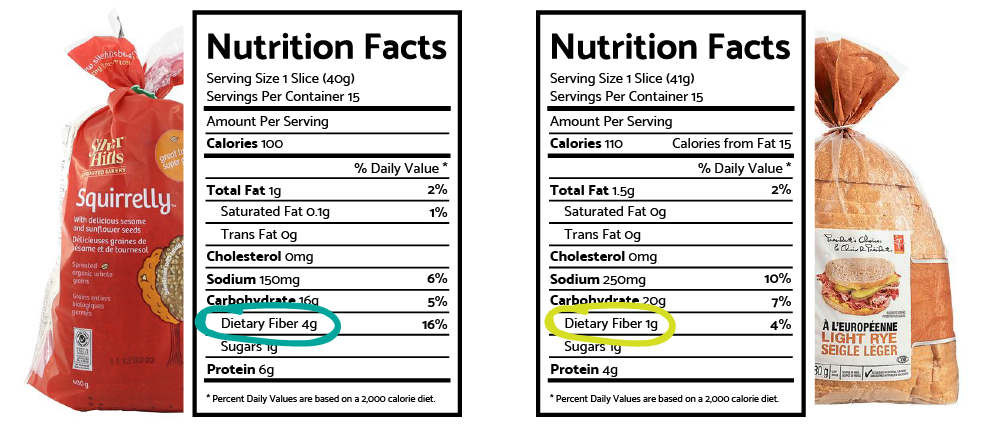Dietitian’s handbook for decoding the food guide
Nutrition Month 2022 is centered on the key ingredients for a healthier tomorrow, which includes building your health literacy. This Nutrition month, we’ve partnered with of Vitality Nutrition‘s Registered Dietitian Courtney Berg to build your food literacy skills. Click here to meet Courtney.
While there is not a one-size-fits-all approach to nutrition, Canada’s Food Guide provides direction towards a healthy eating pattern that will work for most people. The newest food guide has two focuses: what to eat and how to eat. Let’s decode Canada’s Food Guide by exploring the core statements found throughout the guide!
What to eat: healthy food choices
The first part of the food guide features a plate visual that highlights the types of foods and portions to include at meals. The guide encourages Canadians to make it a habit to eat a variety of healthy foods each day through five core statements:

1. Have plenty of vegetables and fruit.
The guide emphasizes making ½ of your plate (or 50% of the meal) vegetables and fruit and encourages fresh, frozen, or canned options!
Dietitian Tip: Consider that ½ plate of vegetables and fruits does not mean that the produce visually presents that way on your plate! You can decorate produce throughout the plate like slicing bananas to top your whole grain toast with peanut butter, loading vegetables into a soup, or combining sautéed vegetables with the other food groups as part of a stir-fry. It’s about making a large percentage of your meal vegetables and fruits when possible rather than adhering to a perfect plate guide portion!
2. Eat protein foods.
The guide emphasizes making ¼ of your plate (or 25% of the meal) a protein food. The guide encourages choosing plant-based protein foods more often like beans, lentils, nuts, and seeds and also highlights animal-based options like lean meats and poultry, fish, shellfish, eggs, lower fat milk and lower fat dairy products.
Dietitian Tip: Protein foods typically require the most preparation, making them more challenging to include when you are less prepared. Try opting for convenient protein options like canned beans or lentils that can be quickly stirred into a chili, or combine plain Greek yogurt with granola, berries, and seeds for an easy breakfast. Taking time to prepare a few protein sources for meals and snacks is another great strategy to make protein accessible! For example, preparing grilled chicken to add to salads or sandwiches or hard boiling eggs for breakfast or a snack.
3. Choose whole grains.
The guide recommends that ¼ of your plate (or 25% of the meal) be composed of whole grains. It also suggests choosing whole grains over refined grains to reduce chronic disease risk.
Dietitian Tip: Choosing whole grains means consuming more beneficial fibre. Investigate food labels to choose grains that have more fibre!

4. Make water your drink of choice.
The guide states that making healthy drink choices is as important as your food choices and to make water your drink choice to stay hydrated and avoid excess sugars, salt, or saturated fat.
Dietitian Tip: If you struggle to drink enough water throughout the day, try sprucing it up with some low-sugar, flavourful add-ins like sliced cucumber, fresh mint, or frozen berries. You might also opt for other low-sugar drink options like unsweetened tea or sparkling water!
5. Limit highly processed foods.
The guide boldly states to limit highly processed foods and drinks because they are high in saturated fat, sodium, and sugar and are not a part of a healthy eating pattern.
Dietitian Tip: Most people recognize that processed foods are not healthy promoting, yet, as a dietitian I’ve found the mindset of demonizing certain foods or overly restricting ‘unhealthy’ foods to be an ineffective approach to healthy eating. When we focus on what we “shouldn’t” eat, we actually give more attention to those foods and potentially desire them more often. For example, if you never allow yourself to eat or buy chips (but you love them!) then chips become a novel food. When you eventually have access to chips, perhaps at a social event, you may find yourself overeating. For some, this can lead to a cycle of over-eating and feeling guilty about choosing a ‘less healthy’ food. So the attempt to develop a healthy eating pattern by restricting highly processed foods actually facilitated unhelpful thought patterns and food choices.
As a dietitian, I’ve found a more effective approach is to focus on adding nutritious foods when possible: like eating plenty of vegetables and fruits, whole grains, protein, and water as stated in the guide. The protein, fibre, and volume in these foods and beverage choices help to regulate appetite and naturally nudge out processed foods or make it easier to eat them in moderation.
In addition to recommendations on how to build your meals, the guide reminds Canadians that food marketing can influence your choices and to use food labels to make informed choices!
How to eat: healthy eating habits
Unlike past versions of the food guide, the revised food food guide acknowledges that healthy eating is more than the foods you eat. It is also about where, when, why and how you eat. The guide recommends four core habits and delves into specific tips for each statement:
1. Be mindful of your eating habits. By taking time to eat and noticing when you are hungry and when you are full you can better understand your unique nutrition needs and the factors that affect your food choices.
2. Cook more often. By cooking at home you can more easily choose healthy ingredients outlined in the guide while saving money and preparing meals your family enjoys!
3. Enjoy your food. The guide encourages Canadians to focus on the joy of foods which includes the taste but also the food-related activities that go along with eating. For example, socializing at meal times, growing and harvesting your own ingredients, integrating culture and food traditions, trying new foods, or creating an enjoyable eating environment like listening to music while preparing and eating a meal!
4. Eat meals with others. Enjoying healthy foods with family, friends, neighbours or co-workers can contribute to a healthy lifestyle by providing social connection, sharing food traditions, or exploring new healthy foods you may not otherwise try!
As a dietitian, I believe that these eating habits are the most impactful statements in the guide. The food we eat nourishes our body with key nutrients but also provides an opportunity to connect with our body, the environment, culture, and our family, friends, and community. The way you eat and connect through food is equally as important as the specific foods that are on your plate!
In conclusion
Canada’s Food Guide is a visual tool to create well-balanced meals that meet our nutrition needs and encourages healthy eating behaviours that promote wellness! If you are looking to adopt a healthy eating pattern, try focusing on building in one habit at a time. When you’ve mastered the habit, move onto the next one!
Meet Courtney Berg, RD, B.Sc. Nutrition

About Courtney | Courtney Berg is a Registered Dietitian and completed her Bachelor’s Degree in Nutrition from the University of Saskatchewan in 2016. Her approach to nutrition continues to evolve as she learns and grows with her clients at Vitality Nutrition. However, a holistic approach remains the base of her philosophy with an emphasis on understanding how nutrition as well as sleep, mindset, exercise, and the environment work together to influence whole body health.
About Vitality Nutrition | Vitality Nutrition is a collective of Registered Dietitians and Nutritionists supporting clients in Saskatchewan and across Canada! We incorporate a unique and meaningful approach to food, fitness, and performance that empowers clients to build life-long habits and see lasting results.
